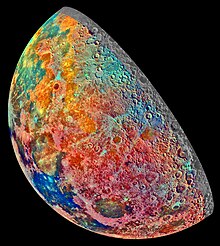
Back جيولوجيا القمر Arabic Xeoloxía de la Lluna AST Geologia de la Lluna Catalan Geologie Měsíce Czech Уйăх геологийĕ CV Månens geologi Danish Selenologie German Γεωλογία της Σελήνης Greek Geología de la Luna Spanish Ilargiaren geologia Basque

The geology of the Moon (sometimes called selenology, although the latter term can refer more generally to "lunar science") is quite different from that of Earth. The Moon lacks a true atmosphere, and the absence of free oxygen and water eliminates erosion due to weather. Instead, the surface is eroded much more slowly through the bombardment of the lunar surface by micrometeorites.[1] It does not have any known form of plate tectonics,[2] it has a lower gravity, and because of its small size, it cooled faster.[3] In addition to impacts, the geomorphology of the lunar surface has been shaped by volcanism,[4][5] which is now thought to have ended less than 50 million years ago.[6] The Moon is a differentiated body, with a crust, mantle, and core.[7]


Geological studies of the Moon are based on a combination of Earth-based telescope observations, measurements from orbiting spacecraft, lunar samples, and geophysical data. Six locations were sampled directly during the crewed Apollo program landings from 1969 to 1972, which returned 382 kilograms (842 lb) of lunar rock and lunar soil to Earth[8] In addition, three robotic Soviet Luna spacecraft returned another 301 grams (10.6 oz) of samples,[9][10][11] and the Chinese robotic Chang'e 5 returned a sample of 1,731 g (61.1 oz) in 2020.[12]
The Moon is the only extraterrestrial body for which we have samples with a known geologic context. A handful of lunar meteorites have been recognized on Earth, though their source craters on the Moon are unknown. A substantial portion of the lunar surface has not been explored, and a number of geological questions remain unanswered.
- ^ Kenneth R. Lang (2003). The Cambridge Guide to the Solar System. Cambridge University Press. p. 170. ISBN 9780521813068.
- ^ NASA 1994, p. 91.
- ^ NASA 1994, p. 93.
- ^ NASA 1994, p. 13.
- ^ Scientific and Technical Information Branch (1986). Status and Future of Lunar Geoscience. NASA. p. 13. ISBN 9780160042089.
- ^ Imster, Eleanor (12 October 2014). "Active moon volcanos in geologically recent times". earthsky.org. EarthSky. Retrieved 25 January 2023.
- ^ NASA 1994, p. 10.
- ^ "Lunar Rocks and Soils from Apollo Missions". NASA. Retrieved 21 November 2022.
- ^ Ivankov, A. "Luna 16". National Space Science Data Center Catalog. NASA. Retrieved 13 October 2018.
The drill was deployed and penetrated to a depth of 35 cm before encountering hard rock or large fragments of rock. The column of regolith in the drill tube was then transferred to the soil sample container... the hermetically sealed soil sample container, lifted off from the Moon carrying 101 grams of collected material
- ^ Ivankov, A. "Luna 20". National Space Science Data Center Catalog. NASA. Retrieved 13 October 2018.
Luna 20 was launched from the lunar surface on 22 February 1972 carrying 30 grams of collected lunar samples in a sealed capsule
- ^ Ivankov, A. "Luna 24". National Space Science Data Center Catalog. NASA. Retrieved 13 October 2018.
the mission successfully collected 170.1 grams of lunar samples and deposited them into a collection capsule
- ^ "China's Chang'e-5 retrieves 1,731 grams of moon samples". Xinhua News Agency. 19 December 2020. Archived from the original on 20 December 2020. Retrieved 19 December 2020.